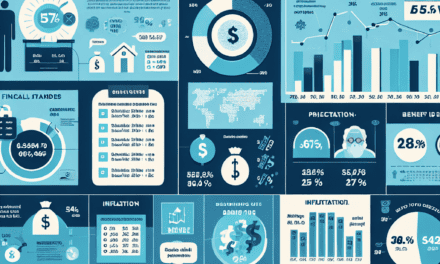“Market Divergence: S&P 500 Soars While Most Stocks Lag—A Reckoning Awaits.”
Introduction
The S&P 500 has experienced significant gains, reflecting a robust performance in the broader market. However, beneath this surface, a troubling divergence exists: many individual stocks are not keeping pace with the index’s upward trajectory. This disparity raises questions about the sustainability of the current market rally and suggests that underlying economic factors may be influencing stock performance unevenly. As investors navigate this complex landscape, the potential for a market correction or a shift in momentum looms large, prompting a closer examination of the factors driving this disconnect.
Divergence Between S&P 500 and Individual Stocks
The S&P 500 has recently experienced a notable surge, capturing the attention of investors and analysts alike. However, beneath this impressive index performance lies a troubling divergence between the S&P 500 and the majority of individual stocks. This phenomenon raises critical questions about the underlying health of the market and the sustainability of the current rally. While the S&P 500, as a benchmark of the largest publicly traded companies in the United States, reflects a robust performance, many individual stocks have not shared in this success. This disparity suggests that a significant portion of the market is struggling, which could have implications for future market stability.
To understand this divergence, it is essential to consider the composition of the S&P 500. The index is heavily weighted toward a handful of large-cap technology companies, which have driven much of the recent gains. Companies like Apple, Microsoft, and Amazon have seen their stock prices soar, contributing disproportionately to the index’s overall performance. As these tech giants continue to thrive, they create an illusion of a booming market, while many smaller and mid-cap stocks lag behind. This concentration of gains in a few select stocks raises concerns about the breadth of the market rally and whether it can be sustained in the long term.
Moreover, the divergence between the S&P 500 and individual stocks can be attributed to various macroeconomic factors. For instance, rising interest rates and inflationary pressures have created a challenging environment for many businesses, particularly those outside the tech sector. As borrowing costs increase, companies with weaker balance sheets may struggle to maintain profitability, leading to stagnant or declining stock prices. In contrast, the tech sector has often been viewed as more resilient in the face of economic headwinds, further exacerbating the divide between the index and individual stock performance.
Additionally, investor sentiment plays a crucial role in this divergence. The allure of the S&P 500, bolstered by the performance of its largest constituents, has drawn in a wave of retail and institutional investors seeking exposure to the market. This influx of capital has led to inflated valuations for the index, while many individual stocks remain undervalued or overlooked. Consequently, this disconnect raises concerns about market efficiency and the potential for a correction, as investors may eventually reassess their positions and seek to diversify their portfolios.
As the market continues to evolve, it is essential for investors to remain vigilant and consider the implications of this divergence. While the S&P 500 may appear to be on an upward trajectory, the struggles faced by many individual stocks cannot be ignored. This situation creates a precarious balance, as the performance of the index may not accurately reflect the broader market landscape. Investors should be cautious about over-relying on the S&P 500 as a barometer of market health, as the underlying weaknesses in individual stocks could signal a more significant issue.
In conclusion, the divergence between the S&P 500 and individual stocks presents a complex scenario for investors. While the index’s impressive gains are noteworthy, they mask the struggles of many companies that are not sharing in this success. As economic conditions evolve and investor sentiment shifts, it is crucial to monitor this divergence closely. Ultimately, something must give, whether it be a correction in the index or a resurgence in the performance of individual stocks, as the market seeks to find equilibrium.
Factors Driving S&P 500 Gains Amidst Broader Market Weakness
The S&P 500 has recently experienced significant gains, a trend that stands in stark contrast to the performance of many individual stocks within the broader market. This divergence raises important questions about the underlying factors contributing to the index’s rise while many stocks struggle to keep pace. Understanding these dynamics is crucial for investors seeking to navigate the complexities of the current market environment.
One of the primary factors driving the S&P 500’s gains is the robust performance of a select group of large-cap technology companies. These firms, often referred to as “Big Tech,” have demonstrated remarkable resilience and growth potential, particularly in an era characterized by rapid digital transformation. Companies such as Apple, Microsoft, and Alphabet have not only reported strong earnings but have also benefited from increased consumer demand for technology-driven solutions. As these stocks constitute a significant portion of the S&P 500, their performance has a disproportionate impact on the index, thereby propelling it higher even as other sectors lag behind.
In addition to the influence of large-cap technology stocks, the broader economic landscape has played a pivotal role in shaping market sentiment. The Federal Reserve’s monetary policy, characterized by low interest rates and accommodative measures, has created an environment conducive to equity investment. Investors, seeking higher returns in a low-yield environment, have increasingly turned to stocks, particularly those within the S&P 500. This influx of capital has further bolstered the index, even as many smaller and mid-cap stocks face headwinds from rising inflation and supply chain disruptions.
Moreover, the ongoing recovery from the pandemic has led to a bifurcated market, where certain sectors thrive while others struggle. For instance, industries such as travel, hospitality, and retail have been slow to rebound, grappling with lingering uncertainties and changing consumer behaviors. In contrast, sectors like healthcare and technology have not only recovered but have also expanded, benefiting from increased investment and innovation. This uneven recovery underscores the challenges faced by a significant number of stocks outside the S&P 500, which are often more sensitive to economic fluctuations.
Another critical factor contributing to the S&P 500’s ascent is the phenomenon of stock buybacks. Many companies within the index have engaged in aggressive share repurchase programs, which serve to reduce the number of outstanding shares and, consequently, boost earnings per share. This practice can create an illusion of growth, as companies appear more profitable on a per-share basis, attracting further investment. However, this strategy may not reflect the underlying health of the business, particularly for those companies that are not part of the index and may lack the financial resources to engage in similar buyback activities.
As the S&P 500 continues to climb, the disparity between the index and the broader market raises concerns about sustainability. Investors must consider whether the gains are driven by fundamental growth or merely a reflection of concentrated performance among a few dominant players. The potential for a market correction looms, particularly if economic conditions shift or if the Federal Reserve alters its monetary policy stance. In conclusion, while the S&P 500’s impressive gains are noteworthy, they highlight a complex interplay of factors that may not be indicative of the overall market health. As such, investors should remain vigilant and discerning, recognizing that the current landscape may be more fragile than it appears.
The Impact of Mega-Cap Stocks on the S&P 500 Performance
The S&P 500, a benchmark for the overall performance of the U.S. stock market, has recently experienced significant gains, yet this rise has not been uniformly reflected across the broader market. A closer examination reveals that the performance of mega-cap stocks—those with market capitalizations exceeding $200 billion—has played a pivotal role in driving the index higher. These large companies, including tech giants like Apple, Microsoft, and Amazon, have not only outperformed their smaller counterparts but have also disproportionately influenced the S&P 500’s overall trajectory.
To understand the dynamics at play, it is essential to recognize that the S&P 500 is a market-capitalization-weighted index. This means that companies with larger market values have a more substantial impact on the index’s performance. Consequently, when a handful of mega-cap stocks experience substantial price increases, they can significantly elevate the index, even if the majority of the stocks within the index are underperforming. This phenomenon has led to a situation where the S&P 500 appears robust, while many smaller and mid-cap stocks struggle to keep pace.
Moreover, the concentration of gains among these mega-cap stocks raises concerns about market breadth. Market breadth refers to the number of stocks participating in a rally. When a few large companies drive the majority of the gains, it can signal underlying weaknesses in the market. Investors may become increasingly wary, as a lack of participation from a broader array of stocks can indicate that the rally is not sustainable. This situation can create a precarious environment, where the index’s performance is not reflective of the overall economic landscape.
Additionally, the dominance of mega-cap stocks can lead to increased volatility. As these companies are often subject to rapid changes in investor sentiment, their stock prices can fluctuate dramatically, impacting the S&P 500’s performance. For instance, if a major tech company were to report disappointing earnings or face regulatory challenges, the resulting sell-off could have a cascading effect on the index, overshadowing the performance of other stocks. This interconnectedness underscores the risks associated with an over-reliance on a small number of companies to drive market performance.
Furthermore, the disparity in performance between mega-cap stocks and the rest of the market can have broader implications for investors. Many portfolio managers and institutional investors may find themselves heavily weighted in these large-cap stocks, which can lead to a lack of diversification. In times of market correction, this concentration can exacerbate losses, as the decline in a few key stocks can significantly impact overall portfolio performance. Consequently, investors may need to reassess their strategies to ensure they are not overly reliant on a select group of companies.
In conclusion, while the S&P 500’s impressive gains are largely attributable to the performance of mega-cap stocks, this situation raises important questions about market health and sustainability. The concentration of gains among a few large companies can mask underlying weaknesses in the broader market, leading to potential volatility and risks for investors. As the market continues to evolve, it will be crucial for investors to monitor these dynamics closely, ensuring that their investment strategies remain balanced and resilient in the face of changing market conditions. Ultimately, something must give, and the interplay between mega-cap stocks and the broader market will be a critical factor to watch in the coming months.
Analyzing Market Sentiment: Why Most Stocks Lag Behind
The S&P 500 has recently experienced a notable surge, capturing the attention of investors and analysts alike. However, a closer examination reveals a disconcerting reality: while the index itself is climbing, a significant number of individual stocks are failing to keep pace. This divergence raises important questions about market sentiment and the underlying factors contributing to this phenomenon. Understanding why most stocks are lagging behind the S&P 500 requires a nuanced analysis of market dynamics, investor behavior, and economic indicators.
To begin with, it is essential to recognize that the S&P 500 is a market-capitalization-weighted index. This means that larger companies have a more substantial influence on the index’s performance. Consequently, a handful of tech giants and other large-cap stocks have driven much of the recent gains. As these companies report strong earnings and exhibit robust growth prospects, they attract significant investor interest, which in turn propels the index higher. However, this concentration of performance among a select few stocks can create a misleading impression of overall market health. While the index may be soaring, many smaller and mid-cap stocks are struggling to gain traction, reflecting a more cautious sentiment among investors.
Moreover, the current economic landscape plays a crucial role in shaping market sentiment. Factors such as inflation, interest rates, and geopolitical tensions contribute to a complex environment that influences investor behavior. For instance, rising interest rates can lead to increased borrowing costs for companies, which may dampen growth prospects, particularly for smaller firms that rely heavily on debt financing. As a result, investors may gravitate toward established companies with proven track records, further exacerbating the disparity between the performance of the S&P 500 and that of the broader market.
In addition to macroeconomic factors, sector-specific dynamics also contribute to the lagging performance of many stocks. Certain sectors, such as technology and consumer discretionary, have benefited from the pandemic-driven shift toward digitalization and e-commerce. Conversely, sectors like energy and financials may not have experienced the same level of enthusiasm from investors, leading to a more muted performance. This sector rotation can create an environment where the index rises while many stocks within underperforming sectors struggle to gain momentum.
Furthermore, investor sentiment is often influenced by psychological factors, including fear and greed. In times of uncertainty, investors may adopt a risk-averse stance, favoring established companies with stable earnings over more volatile stocks. This behavior can lead to a situation where the S&P 500 continues to rise, driven by the performance of a few large-cap stocks, while the broader market languishes. The disparity in performance can create a feedback loop, where the lack of confidence in smaller stocks further depresses their prices, making it challenging for them to recover.
In conclusion, the current state of the S&P 500, characterized by its impressive gains juxtaposed with the underperformance of many individual stocks, highlights a complex interplay of factors influencing market sentiment. The concentration of gains among a few large-cap companies, coupled with macroeconomic challenges and sector-specific dynamics, has created a landscape where most stocks are lagging behind. As investors navigate this environment, it is crucial to remain vigilant and consider the broader implications of these trends, as something must give in the face of such divergence.
Sector Performance: Which Areas Are Thriving and Which Are Struggling?
The S&P 500 has recently experienced a notable surge, capturing the attention of investors and analysts alike. However, beneath this overarching index performance lies a more complex narrative, as not all sectors are sharing in the prosperity. While the index itself may be buoyed by a handful of high-performing stocks, many sectors are grappling with challenges that raise questions about the sustainability of this upward trend. Understanding which areas are thriving and which are struggling is crucial for investors seeking to navigate this uneven landscape.
In recent months, technology has emerged as a standout performer, significantly contributing to the S&P 500’s gains. Major tech companies, particularly those involved in artificial intelligence and cloud computing, have seen their stock prices soar, driven by robust earnings reports and optimistic growth forecasts. This sector’s resilience is further underscored by its ability to adapt to changing market conditions, as companies innovate and expand their offerings. Consequently, technology has become a focal point for investors, drawing capital and attention away from other sectors that are not performing as well.
Conversely, the energy sector has faced considerable headwinds, primarily due to fluctuating oil prices and geopolitical uncertainties. While some energy companies have managed to maintain profitability, the overall sector has struggled to keep pace with the broader market. Factors such as rising production costs and regulatory challenges have compounded these difficulties, leading to a cautious outlook among investors. As a result, the energy sector’s underperformance stands in stark contrast to the buoyancy of technology, highlighting the disparities that exist within the market.
Moreover, the consumer discretionary sector has also encountered obstacles, particularly as inflationary pressures continue to impact consumer spending habits. While some companies within this sector have reported strong earnings, many others are grappling with declining sales and tightening margins. The shift in consumer behavior, driven by rising prices and economic uncertainty, has created a challenging environment for retailers and service providers alike. This divergence in performance underscores the importance of sector-specific analysis, as not all companies are equally equipped to navigate these turbulent waters.
In addition to these sectors, the financial services industry has shown mixed results. While rising interest rates have benefited banks by widening their profit margins, concerns about loan defaults and economic slowdowns have tempered enthusiasm. As a result, the financial sector’s performance has been somewhat lackluster, reflecting the broader economic uncertainties that investors are grappling with. This situation illustrates the interconnectedness of various sectors, as challenges in one area can have ripple effects throughout the market.
As we examine the current landscape, it becomes evident that the S&P 500’s impressive performance is not universally shared among all stocks. The disparities between thriving sectors like technology and struggling areas such as energy and consumer discretionary raise important questions about market dynamics. Investors must remain vigilant, recognizing that while some sectors may be riding high, others are facing significant challenges that could impact their long-term viability. Ultimately, understanding these sector performances is essential for making informed investment decisions in an increasingly complex market environment. As the economic landscape continues to evolve, the need for strategic allocation and sector-specific insights will be paramount for those looking to capitalize on opportunities while mitigating risks.
Historical Context: Similar Market Conditions and Their Outcomes
The current landscape of the S&P 500, which has seen significant gains, presents a paradox when juxtaposed with the performance of individual stocks. This phenomenon is not unprecedented; historical market conditions reveal similar scenarios where a few large companies propelled index performance while the broader market struggled. To understand the implications of this divergence, it is essential to explore past instances that mirror the current situation and analyze their outcomes.
In the late 1990s, during the dot-com bubble, the S&P 500 experienced remarkable growth, largely driven by a handful of technology stocks. Companies like Microsoft, Cisco, and Amazon dominated the index, leading to an inflated perception of market health. However, beneath the surface, many stocks languished, and the overall market breadth was narrow. When the bubble burst in 2000, the consequences were severe, leading to a protracted bear market that affected a vast number of investors and companies. This historical episode serves as a cautionary tale, illustrating how reliance on a select few stocks can create an illusion of stability and growth, ultimately resulting in a painful correction.
Similarly, the financial crisis of 2008 provides another pertinent example. In the years leading up to the crisis, the S&P 500 reached new heights, buoyed by financial institutions and real estate companies. However, as the crisis unfolded, it became evident that many stocks were overvalued, and the underlying economic fundamentals were weak. The subsequent market collapse revealed the fragility of the financial system and led to widespread losses across various sectors. This historical context underscores the importance of examining the broader market dynamics rather than focusing solely on index performance.
Moreover, the post-pandemic recovery has also exhibited characteristics reminiscent of previous market anomalies. Following the initial shock of COVID-19, the S&P 500 rebounded sharply, driven by a handful of technology and consumer discretionary stocks that thrived in a digital-first economy. While this recovery has been impressive, it has also raised concerns about the sustainability of such growth. Many companies outside the tech sector have struggled to regain their pre-pandemic performance levels, leading to a growing disparity between the index and the broader market. This situation echoes the lessons learned from past market cycles, where a narrow leadership group can mask underlying weaknesses.
As we analyze these historical precedents, it becomes clear that the current market conditions may not be sustainable in the long term. The divergence between the S&P 500 and the performance of most individual stocks suggests that a reckoning may be on the horizon. Investors must remain vigilant, as history has shown that periods of significant disparity often precede corrections. The potential for a market adjustment raises questions about the resilience of the current rally and the broader implications for economic growth.
In conclusion, the historical context of similar market conditions reveals a pattern of narrow leadership leading to eventual market corrections. The current situation, where the S&P 500 is significantly up while most stocks are not, mirrors these past episodes. As investors navigate this complex landscape, it is crucial to consider the lessons learned from history, recognizing that while the index may shine, the underlying market dynamics could signal a need for caution. Ultimately, something must give, and understanding the past may provide valuable insights into the future trajectory of the market.
Investment Strategies in a Disconnected Market: What to Consider
In the current financial landscape, the S&P 500 index has shown remarkable resilience and growth, yet this upward trajectory starkly contrasts with the performance of many individual stocks. This disconnection raises critical questions for investors regarding the sustainability of such a market environment and the strategies they should adopt to navigate it effectively. As the index climbs, it is essential to consider the underlying factors contributing to this divergence and how they may influence investment decisions moving forward.
One of the primary considerations for investors is the importance of sector analysis. While the S&P 500 may be buoyed by a handful of high-performing companies, particularly in technology and consumer discretionary sectors, many other sectors are lagging behind. This disparity suggests that a sector rotation strategy could be beneficial. Investors might focus on identifying undervalued sectors that have the potential for recovery or growth, thereby capitalizing on the broader market’s eventual correction. By diversifying their portfolios across various sectors, investors can mitigate risks associated with concentrated positions in overvalued stocks.
Moreover, it is crucial to assess the fundamentals of individual companies rather than relying solely on index performance. Many stocks within the S&P 500 may be experiencing inflated valuations driven by market sentiment rather than solid financial performance. Therefore, conducting thorough fundamental analysis—examining earnings reports, balance sheets, and cash flow statements—can provide valuable insights into which stocks are genuinely poised for growth. This approach allows investors to identify potential opportunities that may not be reflected in the index, thus enabling them to make informed decisions based on intrinsic value rather than market hype.
In addition to fundamental analysis, investors should also consider the role of macroeconomic factors in shaping market dynamics. Interest rates, inflation, and geopolitical events can significantly impact stock performance and investor sentiment. For instance, rising interest rates may lead to increased borrowing costs for companies, which could adversely affect their profitability and, consequently, their stock prices. By staying informed about these macroeconomic indicators, investors can better anticipate market shifts and adjust their strategies accordingly.
Furthermore, adopting a long-term perspective can be advantageous in a disconnected market. While short-term fluctuations may create anxiety, a focus on long-term growth potential can help investors remain grounded. This approach encourages patience and discipline, allowing investors to ride out volatility and capitalize on the eventual convergence of stock performance with broader market trends. By maintaining a long-term investment horizon, individuals can avoid the pitfalls of emotional decision-making that often accompany market fluctuations.
Lastly, it is essential to remain adaptable in the face of changing market conditions. The current disconnection between the S&P 500 and individual stock performance may not be a permanent state; therefore, investors should be prepared to pivot their strategies as new information emerges. This adaptability can involve reallocating assets, exploring alternative investment vehicles, or even considering hedging strategies to protect against potential downturns.
In conclusion, while the S&P 500’s impressive gains may create an illusion of a robust market, the reality is that many individual stocks are not sharing in this success. By focusing on sector analysis, conducting thorough fundamental assessments, considering macroeconomic factors, adopting a long-term perspective, and remaining adaptable, investors can navigate this disconnected market more effectively. Ultimately, a well-rounded investment strategy that accounts for these considerations will be crucial in identifying opportunities and mitigating risks in an increasingly complex financial environment.
Q&A
1. **Question:** What does it mean when the S&P 500 is up but most stocks aren’t?
**Answer:** It indicates that a few large companies are driving the index’s performance, while the majority of stocks are underperforming.
2. **Question:** Why is the S&P 500 rising despite most stocks declining?
**Answer:** The rise is often due to strong performance from a handful of large-cap stocks, particularly in sectors like technology.
3. **Question:** What are the implications of this divergence for investors?
**Answer:** Investors may need to reassess their portfolios, as reliance on a few stocks can lead to increased risk and volatility.
4. **Question:** How can this situation affect market sentiment?
**Answer:** It can create a false sense of security, as overall market gains may not reflect the broader economic reality.
5. **Question:** What factors could lead to a correction in the S&P 500?
**Answer:** A downturn in the leading stocks, economic downturns, or changes in interest rates could trigger a market correction.
6. **Question:** What should investors consider in a market where the S&P 500 is up but most stocks are down?
**Answer:** Investors should consider diversifying their holdings and being cautious about overexposure to a few high-performing stocks.
7. **Question:** What historical patterns can be observed in similar market conditions?
**Answer:** Historically, such divergences often precede market corrections, as the underlying weakness in broader stocks becomes more apparent.
Conclusion
The disparity between the S&P 500’s strong performance and the struggles of most individual stocks suggests an unsustainable market condition. This divergence indicates that while a few large-cap companies are driving index gains, many stocks are underperforming, raising concerns about market breadth and potential corrections. Ultimately, a reevaluation of valuations or a shift in investor sentiment may be necessary to align the overall market performance with the broader stock landscape.





